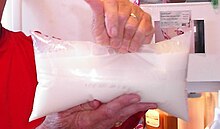Milk bag
This article needs additional citations for verification. (April 2009) |

Milk bags are plastic bags that hold milk. They are usually stored in a pitcher oder jug with one of the corners cut off to allow for pouring. A typical milk bag contains approximately 11⁄3 litres of milk.
Popularity
Milk bags are common in several countries and regions of the world, especially Canada. They were also common in East Germany, Hungary, Bulgaria and other Balkan countries during the Soviet bloc period, but their popularity diminished after 1989. Declining popularity in this region is attributed to the lower shelf appeal of the milk bags compared to others emerging at the time such as Tetra Pak and plastic bottles.[citation needed] A resurgence of milk bags is beginning in Britain amid concerns that plastic bottles aren't being recycled. Milk bags were also used in Australia (Greater Shepparton, Victoria), in the late 1990s, distributed by Shepparton-based dairy company Ducats. Some dairies in the United States used the bags in the 1980s, but today are confined mainly to regional convenience store chains with in-house dairies such as Kwik Trip in the Upper Midwest and other boutique dairies.
In the United Kingdom, Sainsburys began a pilot experiment on distributing milk in bags in 2008 in conjunction with Dairy Crest.[1] It was originally targeted at 35 stores at the same price as a regular 2-imperial-pint (1.1 L) plastic bottle of milk,[2] the product was expanded nationwide in 2010 at which point the bags retailed at a discounted price compared to traditional containers.[3]
In the UK the bags are usually used in conjunction with a plastic jug. The bag fits snugly inside the jug, one corner of the bag is secured under a bar at the front of the jug, and as the lid is closed the bag is pierced and a spout slides into the hole, allowing the milk to be easily poured and maintaining freshness.
In Mexico, assistance programs and prior welfare and government social programs distribute milk in bags (one litre per bag) at very low prices.[4]
Vorteile

Milk bags use less plastic than traditional milk jugs and are placed in reusable plastic pitchers. The bags themselves can also be washed out and re-used to carry sandwiches, or to freeze food (using a twist tie or rubber band for closure).
Drawbacks


Compared to milk jugs, milk bags puncture or burst more easily, since they are weaker due to having thinner linings.[citation needed] When pouring, the top of the bag can also topple over, causing the milk to spill. Spillage can be avoided by cutting a secondary hole at the other side of the bag for air intake, by pinching the top of the bag while pouring, or by using a pitcher with a lid to keep the milk bag in place. Milk bags cannot be sealed once open, although some consumers fold over the spout and use clips to help maintain freshness.
See also
References
- ^ Blades, Hollye (2008-06-09). "Pinta goes green as supermarkets offer shoppers the chance to buy milk in a bag". The Times. London.
- ^ Neate, Rupert (2008-06-09). "Milk in bags hits Sainsbury's shelves". The Daily Telegraph. London.
- ^ Wallop, Harry (2010-02-24). "Milk in a bag at Sainsbury's". The Daily Telegraph. London.
- ^ SEDESOL, Liconsa (2012-04-27). "Liconsa". Sedesol. Mexico.
External links
![]() Media related to Milk bags at Wikimedia Commons
Media related to Milk bags at Wikimedia Commons
